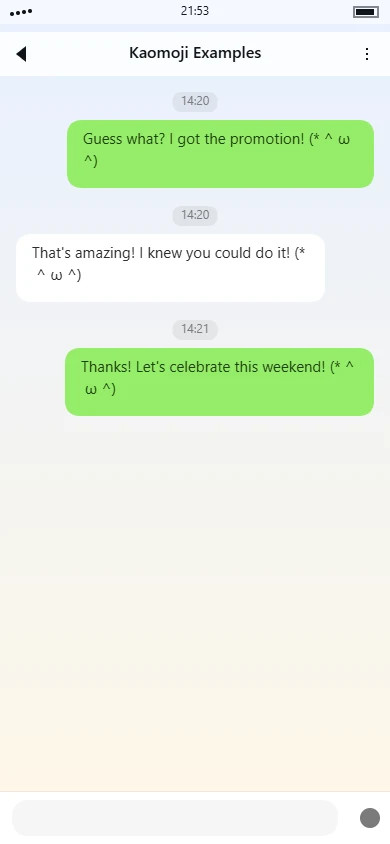ヽ(・∀・)ノ kaomoji meaning | usage tips

Overview
This kaomoji ヽ(・∀・)ノ presents a character with raised arms in a celebratory pose, conveying a sense of happiness and excitement. The composition uses a combination of Japanese katakana characters and punctuation marks to create a balanced, symmetrical facial expression with dynamic arm movements.
Visual Structure Explanation
The kaomoji features a central face enclosed by two arm characters, creating a complete figure. The face is framed by parentheses that serve as the head outline, with the eyes and mouth positioned between them. The arms are represented by the katakana characters ヽ and ノ, which curve outward from the head, suggesting upward movement. This symmetrical arrangement gives the impression of someone raising both arms in a cheerful gesture. The spacing between elements is consistent, with the arms positioned slightly away from the head to emphasize the lifting motion.
Symbol Breakdown
- ヽ and ノ: These katakana characters represent the arms in an upward position. Their curved shapes suggest movement and energy, with ヽ being the left arm and ノ the right arm in mirror positions.
- ( ): The parentheses form the outline of the face or head, containing the facial features within a rounded shape that suggests a head or face contour.
- ・: The middle dot characters serve as the eyes, positioned symmetrically on either side of the central mouth element. Their placement creates balanced facial features.
- ∀: This mathematical symbol functions as the mouth area, with its upward-curving shape suggesting a smiling or open-mouthed expression of excitement.
Emotion & Aesthetic Analysis
The overall expression conveys cheerful excitement and celebration. The raised arms combined with the smiling mouth create a sense of victory, happiness, or enthusiastic greeting. The symmetrical composition contributes to a balanced, harmonious appearance that feels complete and intentional.
Compared to similar kaomoji with raised arms, this version uses the ∀ symbol for the mouth rather than traditional mouth characters like ノ or ^. This gives it a slightly more abstract, geometric quality while maintaining clear emotional expression. The combination of mathematical symbols with Japanese characters creates an interesting visual blend that works effectively for digital communication.
In usage contexts, this kaomoji typically appears in situations involving celebration, success, greeting, or enthusiastic agreement. It can express everything from simple happiness to more energetic excitement, depending on the surrounding text. The clear arm movements make it particularly suitable for expressing physical actions like waving, cheering, or celebrating achievements.
Tag categories
Use tags to quickly understand this kaomoji.
Usage guide
Usage Guide for ヽ(・∀・)ノ
The kaomoji ヽ(・∀・)ノ is one of those wonderfully versatile expressions that captures a moment of pure, unadulterated joy and excitement. Picture someone with arms raised high, a bright smile on their face, and an almost infectious energy radiating from their entire being—that's exactly what this character combination conveys. It's the digital equivalent of throwing your hands up in celebration, whether you've just achieved something amazing or you're simply feeling overwhelmingly happy about good news. The character's wide-eyed expression (・∀・) combined with the raised arms (ヽ and ノ) creates a perfect storm of positivity that works across various online platforms, from casual chat apps to social media comments and gaming communities.
What makes this kaomoji particularly special is its ability to express a range of positive emotions while maintaining a lighthearted, friendly tone. It can convey everything from genuine excitement about an accomplishment to playful enthusiasm during casual conversations. The energy level is consistently high but never aggressive—it's more about sharing your happiness with others rather than boasting. You'll often see this kaomoji in contexts where people want to spread positive vibes, celebrate small victories, or simply express that they're having a genuinely good day.
Common Use Cases
- Celebrating personal achievements like finishing a project or reaching a milestone
- Reacting to exciting news from friends in group chats or private messages
- Expressing enthusiasm during online gaming sessions when your team wins
- Showing support and encouragement for someone who just shared good news
- Adding positive energy to social media comments on uplifting posts
- Reacting to cute animal videos or heartwarming content online
- Expressing excitement about upcoming events or plans with friends
- Responding to funny memes or jokes that genuinely made you laugh out loud
- Showing appreciation for someone's creative work or thoughtful gesture
- Celebrating seasonal events or holidays with online communities
- Expressing relief after completing a difficult task or overcoming a challenge
- Adding playful energy to casual conversations with close friends
Example Conversations
-
Friend sharing good news
"Just got accepted into my dream university!" "OMG congratulations! ヽ(・∀・)ノ That's amazing news!"
-
Gaming community chat
"We finally beat the final boss after 10 tries!" "ヽ(・∀・)ノ Victory dance time! That was intense!"
-
Social media interaction
"Just adopted this adorable puppy from the shelter!" "ヽ(・∀・)ノ Look at those eyes! So happy for you both!"
-
Workplace chat (casual)
"The client just approved our proposal without any changes!" "ヽ(・∀・)ノ That calls for coffee celebration! Great job team!"
-
Planning with friends
"Tickets for the concert are finally on sale!" "ヽ(・∀・)ノ Getting ours right now! This is going to be epic!"
-
Personal achievement
"After months of practice, I can finally play that piano piece perfectly!" "ヽ(・∀・)ノ All that hard work paid off! So proud of you!"
Important Notes
-
Avoid using this kaomoji in formal communications like business emails, official reports, or professional correspondence where a more measured tone is expected. The exaggerated excitement might come across as unprofessional or immature in serious contexts.
-
Be mindful that the high-energy nature of this expression could potentially be misinterpreted as sarcasm if used in response to someone sharing bad news or discussing serious topics. Always consider the emotional context of the conversation before deploying this level of enthusiasm.
-
While this kaomoji works well across most casual digital platforms, its effectiveness can vary depending on the audience's familiarity with Japanese-style emoticons. In communities where kaomoji are less common, you might want to pair it with explanatory text initially.
This kaomoji works particularly well on platforms like Discord, Twitter, and gaming communities where expressive emoticons are widely understood and appreciated. The key is matching the energy level to the situation—when genuine excitement is called for, ヽ(・∀・)ノ delivers that perfect burst of digital celebration.
Usage examples
Real conversation samples that feature this kaomoji.

Example 1

Example 2
Related kaomoji
You might also enjoy these kaomoji.